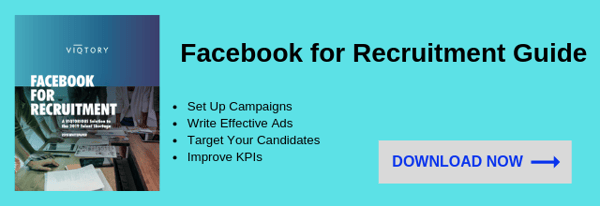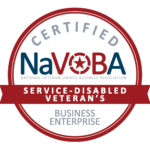Content marketing plays a more prominent role in the recruitment landscape than ever before. Marketers have gotten smarter about the way they produce content, personalizing it for their target audience and even automating when and where that content is shown. Personalizing content makes for a more relatable experience for the audience, which in turn leads them to develop loyalty.
These same principles apply to recruitment marketing.
The most successful recruitment marketers are able to make the candidate experience personalized at every stage, which is key to not just finding candidates, but finding the right ones. Recruiting military veterans is not unlike recruiting any other kind of target audience, you just need to know what they value, what they're looking for and what their job search experience is like.
It's time you start thinking about candidates the same way you would consumers. It's about building relationships, not just processing an application.
DOWNLOAD OUR FACEBOOK FOR RECRUITMENT GUIDE
Here are three ways to make your candidate experience for military veterans a more personal one.
1.) Know Your Veterans
Content marketers live by the rule that their content must be relevant to their audience. It must resonate with them and inspire a response. Recruitment marketers should likewise follow the rule that their content be highly relevant to their target candidates.
We said earlier that recruiting military veterans is similar in many ways to any other kind of niche audience, and it's true, but there are some key differences. For one, some military veterans may not be sure what kind of civilian career they're looking for. This makes it important for you to know what kind of military veteran you're looking to recruit. What do I mean?
The military is like is not unlike any other organization in that they have different jobs performed by different individuals (duh). The key for you as a recruiter is to know what types of military jobs require skills that translate to your open positions.
One way you might do this is by researching the individual jobs in the military. The Army and Marine Corps use Military Occupation Specialty codes (MOS) to identify their jobs. The Air Force uses Air Force Specialty Codes (AFSC), while the Navy uses a system of ratings and classifications. Doing some research on the duties of each of these classifications will give you insight as to what types of military veterans you should target with your recruitment marketing materials.
For example, if you have an open position that requires, say, IT expertise, you can use job ads with personal messaging to veterans who hold a MOS, AFSC...etc that involves IT work. By doing this, you will no doubt catch the eye of the right candidate, while reducing the risk of attracting unqualified candidates.

(An example of an Army MOS description)
2.) Personalize Your Content
Your goal as a recruiter is to find the right candidate. One of the best ways to do that is to stand out from the pack. Creating unique, dynamic content will allow you to cut through the static and deliver a candidate experience unlike your competitors. Here are some ideas for creating more engaging content:
Use Video
Along with being a more engaging content delivery method, video allows you to humanize your company and showcase your employer brand better than other content. You can use video in job ads, landing pages and job descriptions directed towards military veterans. A great idea is to have any of your current military veteran employees appear in the videos to offer their success story.
Here's a great example of how Verizon uses video to personalize their message to veterans.
Landing Pages
If you are directing military veterans to a landing page with the goal of applying for a position, you will want to make sure that page speaks to their values and interest, just like you would with any another target audience. Ideally, your landing page will be made specifically for the job you are recruiting for, instead of a "blanket" landing page for all veterans.
Remember, the more you can personalize their experience, the happier the candidate will be.
Job Descriptions
Your job descriptions are an opportunity for you to really pull the candidate in to give them a closer view. I love when companies use video in place of text, as it provides a more "first person" experience of what they can expect. Some of the best job description videos I've seen involve messages from the hiring manager/team leader, and also some of the team members.
Your job descriptions should use language that speaks to the candidate. In this case, you might want to use phrases from the military in place of normal industry jargon if possible.
3.) Consistent Communication
One of the most frustrating aspects of the job search for candidates is lack of communication from employers. Don't leave your candidates in the dark. If you are going to be using an automation system, consider having different campaigns for different job types. It's important to remember than even personalizing follow up materials can have a positive impact.
Candidates, both active and passive, want to be addressed on their own terms. It's important to know which group of candidates you are targeting. Passive candidates might take a little bit more convincing to even click through to view a job description, whereas active candidates are ready to go. Utilize the platforms that your audience uses, and feed them consistent, relevant ads and content.


